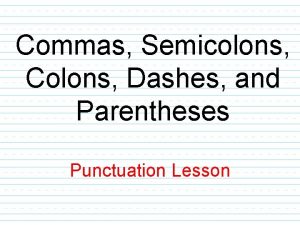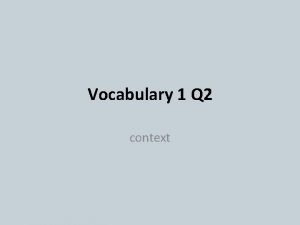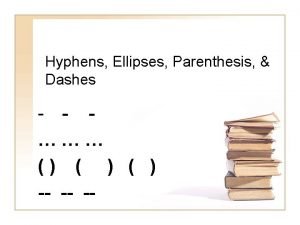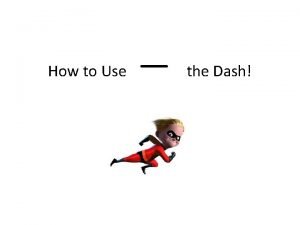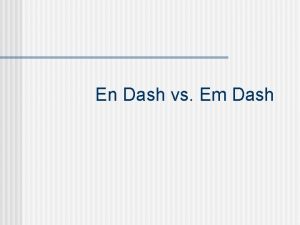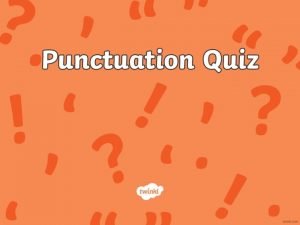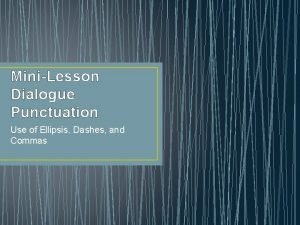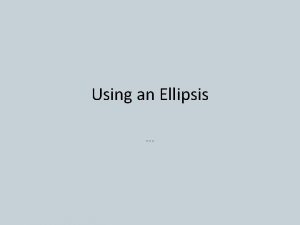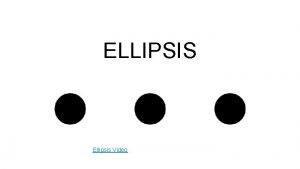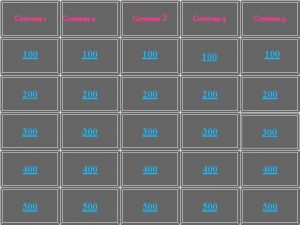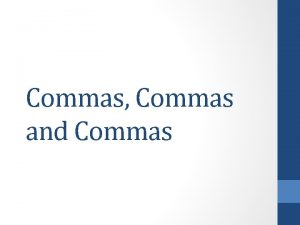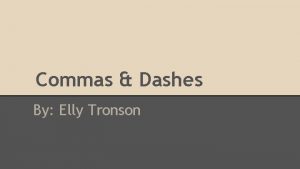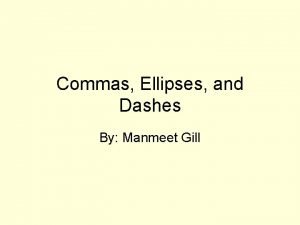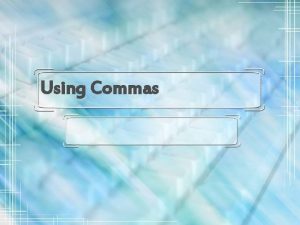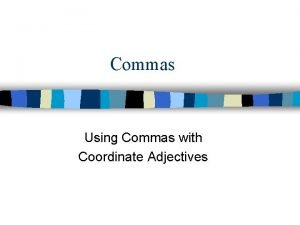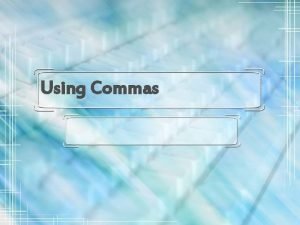Unit 3 Commas Ellipsis Dashes ELACC 8 L










![Ellipsis • An ellipsis [ … ] proves to be a handy device when Ellipsis • An ellipsis [ … ] proves to be a handy device when](https://slidetodoc.com/presentation_image_h/a2be9f0f8abfeb701d79713fd076f76f/image-11.jpg)

- Slides: 12

Unit 3: Commas, Ellipsis, & Dashes ELACC 8 L 2 a: Use punctuation (comma, ellipsis, dash) to indicate a pause or break. ELACC 8 L 2 b: Use an ellipsis to indicate an omission.

Comma Usage Rules • A comma is used to separate words or groups of words so that the meaning of a sentence is clear. • There are eight rules for using commas.

Comma Rule #1 • Items in a series: Use commas to separate items in a list of three or more. • Remember that an “item” may refer to a noun, verb, or adjective phrase. • Note: Usage of a comma to separate the second-to-last from the last item is optional. Example: I need to buy eggs, milk, lettuce, and bread.

Comma Rule #2 • Use a comma to separate independent clauses (complete thoughts) when they are joined by the following conjunctions: For And Nor But Or Yet So Note: The comma should come before the conjunction. Complete Thought #1 Example: I want to buy the new jacket, but it is too expensive. Complete Thought #2

Comma Rule #3 • Use a comma to separate a dependent clause (incomplete thought) from and independent clause (complete thought). • Here are some examples of sentences with dependent and independent clauses: 1. When I get older, I will be able to drive. = (Dependent), (Independent). 2. If you are good, I will buy you a toy. = (Dependent), (Independent). Example: Without water, the plant will die.

Comma Rule #4 • Use a comma(s) to separate any word or phrase from the rest of the sentence that is not essential to the sentence’s meaning. This phrase usually provides extra information about the subject. • Here are some examples of sentences with words/phrases that are not essential to the sentence’s meaning: 1. My brother, a 26 year old male, is watching TV. 2. Amy Rivers, my best friend, is going to the mall today. 3. I am ready for my dad, a hard working man, to come home. Example: My mother, on the other hand, does not like chocolate.

Comma Rule #5 • Use a comma to separate a quotation from the rest of a sentence. Example: “We need to buy more sugar, ” she said, “before it runs out!” Practice: Add commas where needed 1. “I am tired” he muttered. 2. He said “We need to lower taxes!”

Comma Rule #6 • Use a comma to separate an introductory element from the rest of a sentence. Example: Hi, how are you? Practice: Add commas where needed 1. However I am very good at math. 2. Wait is there another way? 3. Unfortunately we do not have enough time.

Comma Rule #7 • Use a comma to separate the name of a city from a country or state. Example: I live in Douglasville, Georgia. Practice: Add commas where needed 1. We are moving to Spokane Washington. 2. I visited Florence Italy last summer. 3. The hurricanes hit Tulsa Oklahoma and Destin Florida.

Comma Rule #8 • Use a comma to separate the day of the week, the day of the month, and the year. Example: Today is Tuesday, March 11, 1943. Practice: Add commas where needed 1. Tomorrow will be Wednesday March 12 2014. 2. George Washington was born on February 22 1732.
![Ellipsis An ellipsis proves to be a handy device when Ellipsis • An ellipsis [ … ] proves to be a handy device when](https://slidetodoc.com/presentation_image_h/a2be9f0f8abfeb701d79713fd076f76f/image-11.jpg)
Ellipsis • An ellipsis [ … ] proves to be a handy device when you're quoting material and you want to omit some words. • The ellipsis consists of three evenly spaced dots (periods) with spaces between the ellipsis and surrounding letters or other marks. • Let's take the sentence, "The ceremony honored twelve brilliant athletes from the Caribbean who were visiting the U. S. " and leave out "from the Caribbean who were": Example: The ceremony honored twelve brilliant athletes … visiting the U. S.

Dashes — • Do not use dashes to set apart items when commas would do the work for you. • There are no spaces between the dash and the letters on either side of a dash. Examples: 1. All four of them—Bob, Jeffrey, Jason, and Brett—did well in college. 2. e-mail 3. In time: 6: 30– 8: 45 p. m. 4. Between numbers 1 -10
 When to use commas semicolons colons and dashes
When to use commas semicolons colons and dashes Elacc significato
Elacc significato When to use dashes sat
When to use dashes sat Dashes hyphens and ellipses
Dashes hyphens and ellipses Different kinds of dashes
Different kinds of dashes Comma vs em dash
Comma vs em dash Dashes to indicate parenthesis
Dashes to indicate parenthesis Alphabet of lines
Alphabet of lines Colons semicolons and dashes
Colons semicolons and dashes What is parentheses
What is parentheses Which sentence uses dashes correctly?
Which sentence uses dashes correctly? Dialogue mini lesson
Dialogue mini lesson How to use an ellipsis
How to use an ellipsis
